Beyond Screen-Printing: 8 Alternative and Creative Design Techniques for Custom Socks
| Apr, 05 , 24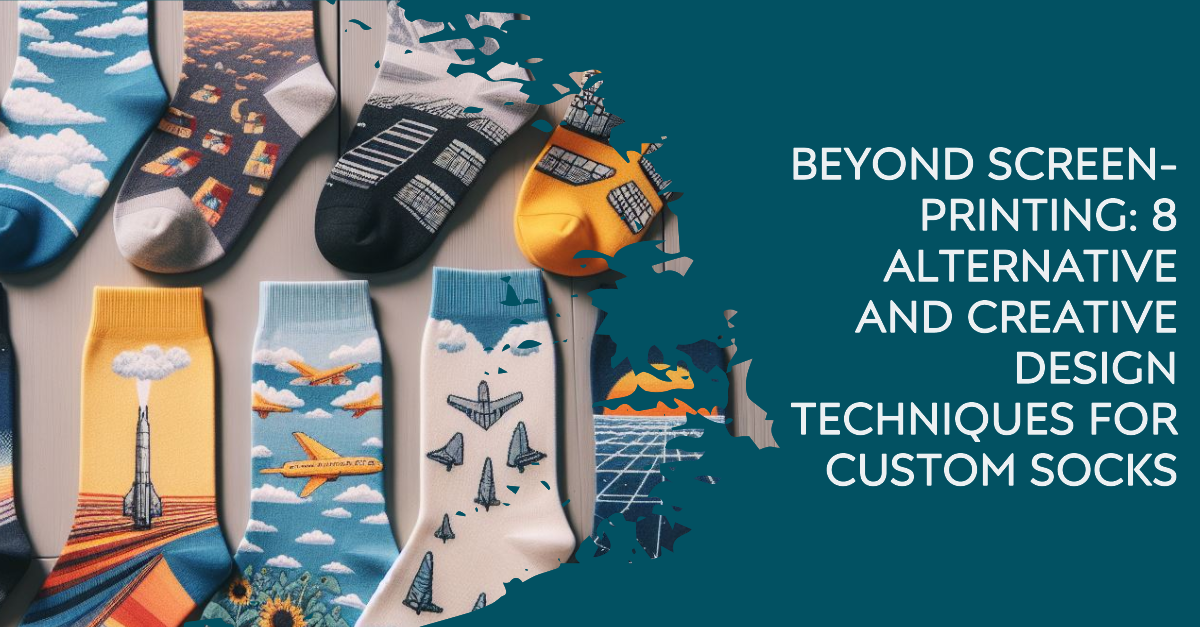
Screen printing reigns supreme in custom sock manufacturing, but what if you crave something more? Do you dream of socks splashed with dazzling metallics, intricate 3D designs, or socks that glow under a blacklight? The guide delves into 8 alternative printing techniques that push the boundaries of custom sock design. From eye-catching dye sublimation to mind-bending all-over printing, we'll unveil a treasure trove of options to transform your custom sock dreams into vibrant, show-stopping realities. So, ditch the ordinary and embrace the extraordinary – let's explore the exciting world of alternative printing techniques for custom socks!
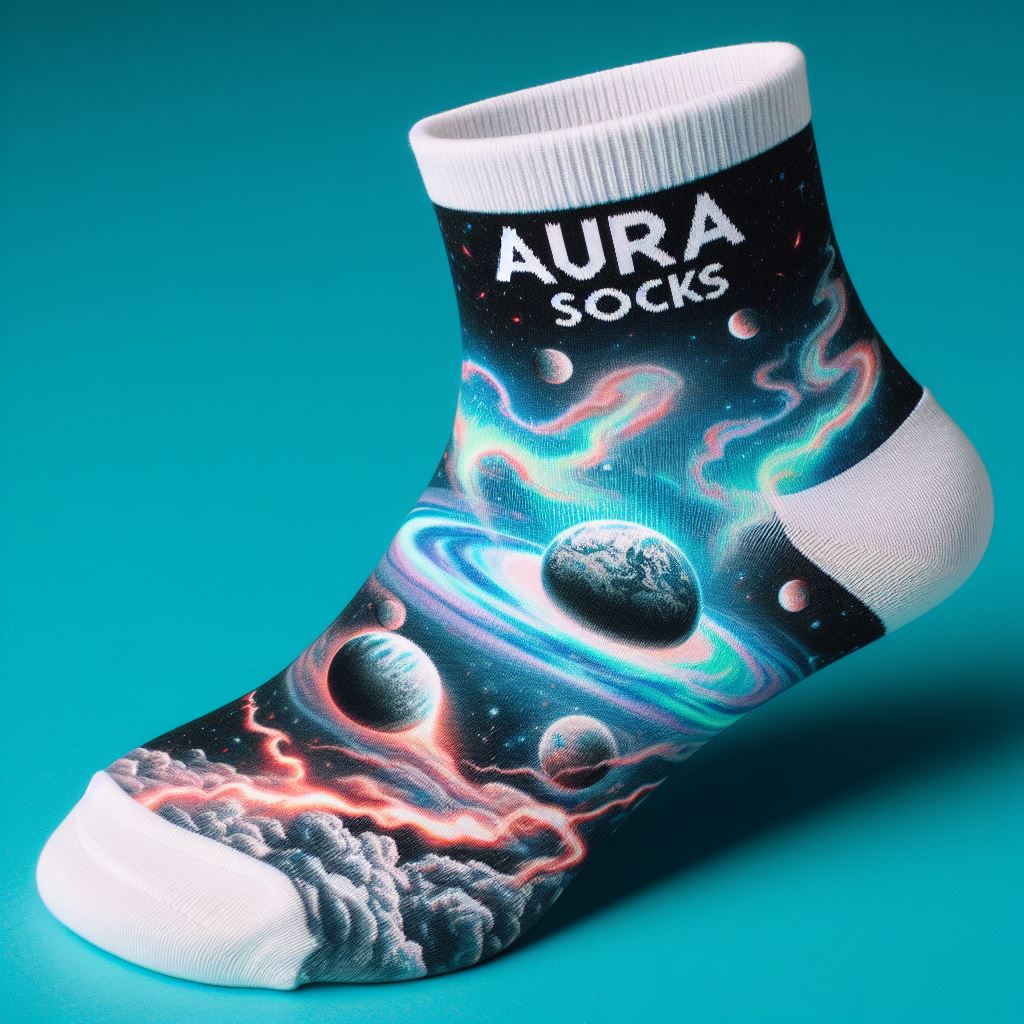
1. Direct-to-Garment (DTG) Printing: A Colorful Option for Custom Socks
Direct-to-garment (DTG) printing has become a popular alternative to screen-printing for custom socks, especially for small batch orders or designs with intricate details. Here's a breakdown of the DTG process, its pros and cons, and ideal use cases for creating unique custom socks:
The DTG Process:
Imagine a specialized inkjet printer for fabrics. DTG printing works similarly, using water-based inks directly injected onto the sock surface. Here's a simplified breakdown:
- Pre-treatment: The sock fabric receives a solution to enhance ink adhesion and vibrancy.
- Printing: The DTG printer precisely jets inks onto the pretreated sock, replicating your design digitally.
- Curing: The printed socks undergo heat curing to ensure ink permanence and washfastness.
Pros of DTG Printing:
- Vibrant Colors and Details: DTG excels at producing high-resolution prints with a wide color gamut, perfect for intricate designs or photorealistic images.
- Small Batch Viability: Unlike screen printing, DTG doesn't require expensive screen setups, making it ideal for smaller custom sock orders.
- Design Flexibility: DTG accommodates complex designs, gradients, and even photo printing, offering greater design freedom.
Cons of DTG Printing:
- Limited Material Compatibility: DTG inks work best with natural fibers like cotton. Printing on synthetic materials might require additional processes or specialized inks.
- Potential for Feeling: The ink can leave a slightly raised texture on the sock compared to screen-printing, though modern technology minimizes this effect.
- Cost per Sock: While DTG is cost-effective for small batches, the cost per sock might be slightly higher than screen-printing for larger orders.
Perfect for:
- Small Batch Orders: Ideal for creating limited-edition runs or personalized custom socks.
- Complex Designs: If your vision involves intricate details, gradients, or photorealistic elements, DTG is a great choice.
- Full-Color Designs: Showcase vibrant, full-color designs that make a bold statement.
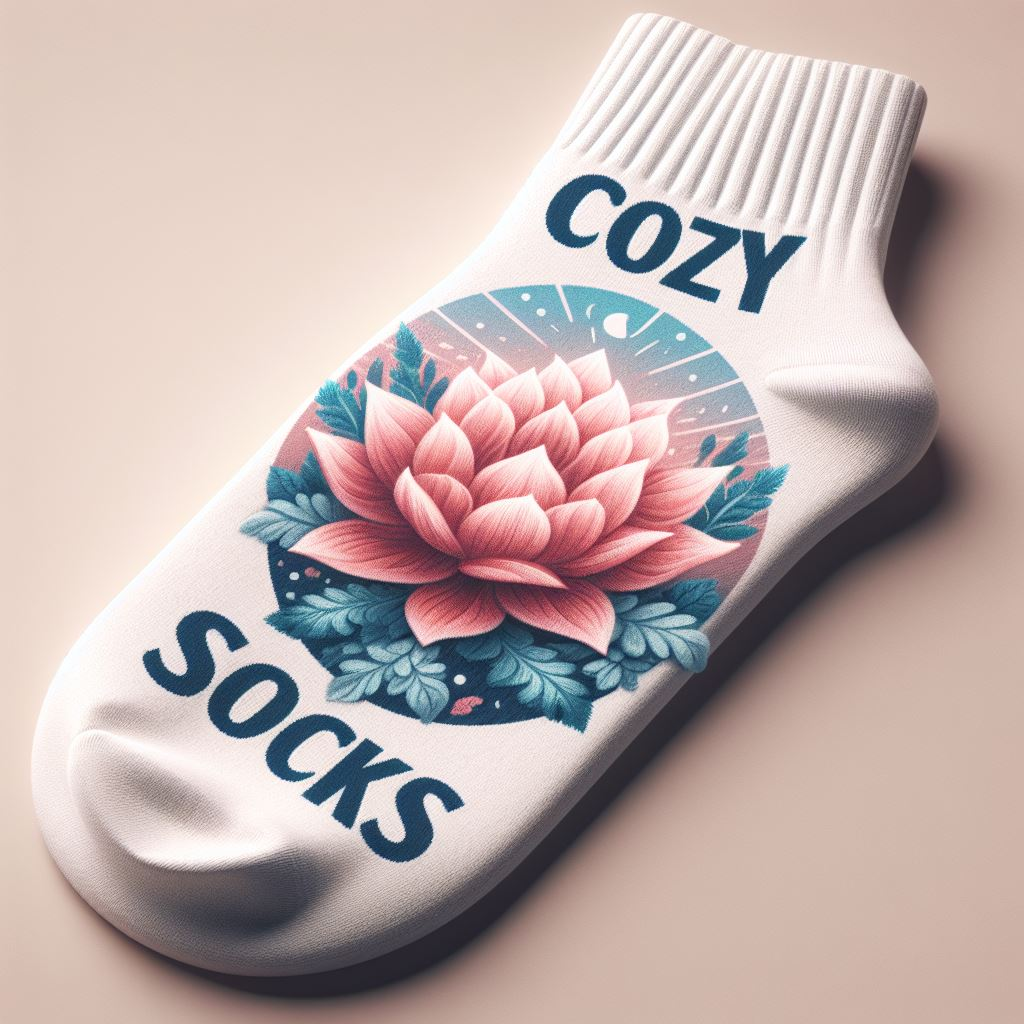
2. Dye Sublimation Printing: Transforming Socks into Artistic Canvases
For those seeking to create custom socks that burst with color and seamless, all-over designs, dye sublimation printing emerges as a revolutionary technique. The process transcends traditional printing methods, transforming socks into vibrant artistic expressions.
The Art of Dye Sublimation:
Dye sublimation isn't simply printing ink onto fabric. It involves a fascinating interplay of heat and pressure:
- Design and Printing: Your custom sock design is printed onto a special transfer paper using sublimation inks.
- Heat Transfer: The transfer paper is placed against the sock fabric and subjected to intense heat and pressure.
- Dye Transformation: Under these conditions, the sublimation inks transform from a solid state directly into a gas, bypassing a liquid phase.
- Fabric Bonding: The gaseous inks penetrate the sock's polyester fibers, essentially dyeing them from within, creating a permanent and vibrant design.
Pros of Dye Sublimation Printing:
- All-Over Printing: Unlike other techniques, dye sublimation allows printing across the entire sock surface, including seams and toes, for a seamless, edge-to-edge design.
- Unmatched Vibrancy: The process results in exceptionally vivid colors with smooth transitions, ideal for photorealistic designs or complex graphics.
- Washfast and Durable: Since the dye becomes part of the fabric, the design becomes highly resistant to fading and washing.
Cons of Dye Sublimation Printing:
- Material Limitations: Dye sublimation works best with polyester fabrics. While polyester blends might work, pure cotton socks won't yield optimal results.
- Minimum Order Quantities (MOQs): This technique often has higher MOQs compared to some other methods due to the specialized equipment involved.
- Design Suitability: Solid colors or designs with sharp lines excel with dye sublimation, while detailed elements might appear slightly blurred.
Perfect for:
- All-Over Designs: If you envision socks with intricate patterns or designs that wrap around the entire sock, dye sublimation is the way to go.
- Photorealistic Images: Bring your favorite photos or artwork to life on custom socks with stunning vibrancy.
- Activewear Socks: The wash-fast nature of dye sublimation makes it ideal for creating custom athletic socks that maintain their color intensity.
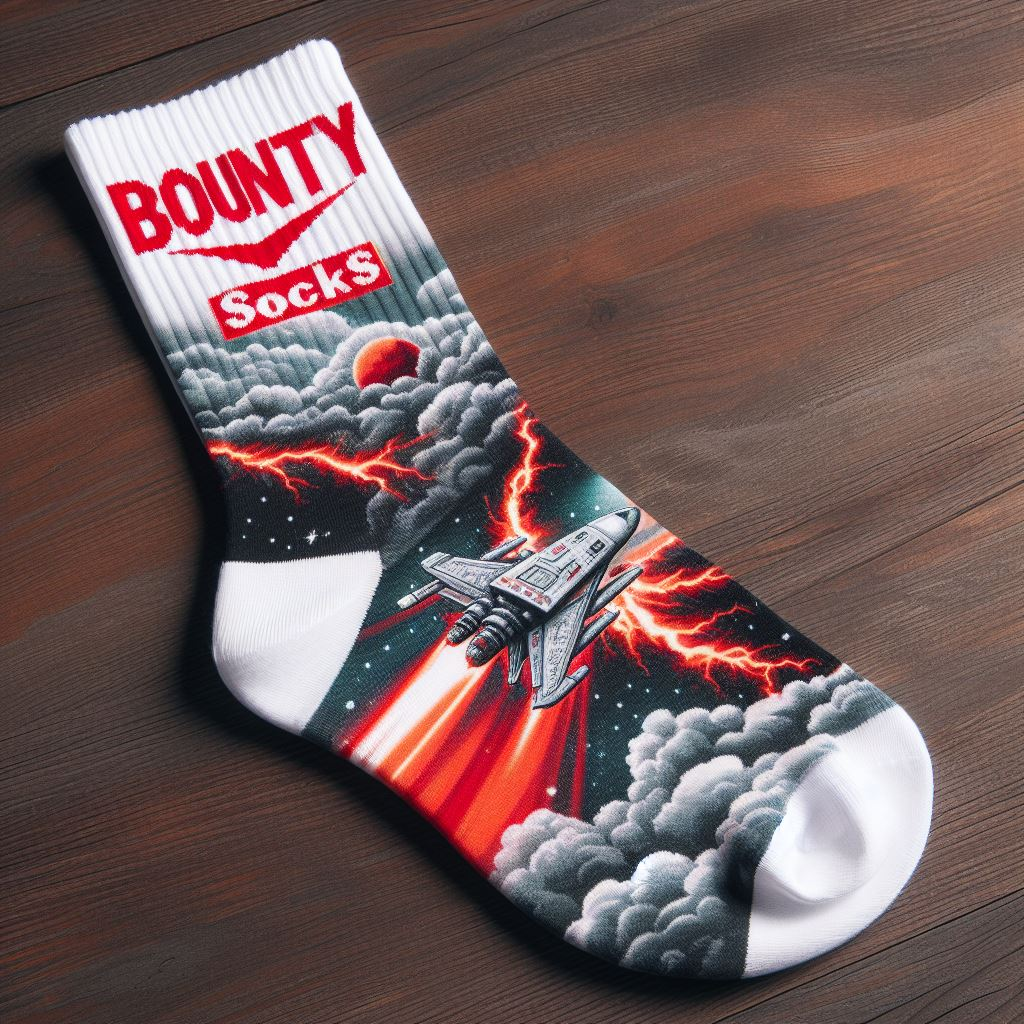
3. Heat Transfer Printing: A Simple Approach for Personalized Sock Pizazz
Heat transfer printing offers a quick and straightforward method for adding a touch of personalization or branding to your custom socks. This technique utilizes pre-made designs or heat transfer vinyl (HTV) to create custom socks with a bit less fuss compared to other methods.
The Heat Transfer Process:
The beauty of heat transfer printing lies in its relative simplicity:
- Design Creation: You can use pre-made heat transfer designs or create your own using HTV material and a cutting machine.
- Heat Press Application: The chosen heat transfer design or HTV is positioned on the sock surface. A heat press applies heat and pressure, adhering the design to the sock fibers.
Pros of Heat Transfer Printing:
- Simple and Affordable: This method requires minimal equipment and expertise, making it a cost-effective option for small-scale customization.
- Wide Design Availability: A vast array of pre-made heat transfer designs are readily available, offering a convenient way to personalize socks.
- DIY Friendly: For those feeling creative, HTV allows you to create your custom designs for a personalized touch.
Cons of Heat Transfer Printing:
- Limited Design Complexity: Heat transfer designs typically feature solid colors or simple graphics, with limitations on intricate details or photorealistic elements.
- Durability Considerations: While heat-pressed designs can be durable, they might not withstand vigorous washing or harsh detergents like other printing methods.
- Potential for Cracking or Peeling: Over time, or with improper application, heat transfer designs might crack or peel from the sock surface.
Perfect for:
- Small Batch Personalization: Adding names, initials, logos, or simple designs to a few custom socks is ideal for heat transfer printing.
- Promotional Giveaways: Create custom socks with your brand logo or slogan for a cost-effective promotional giveaway.
- DIY Projects: For a fun and creative activity, experiment with HTV to design your unique sock embellishments.

4. Sparkling Statements: Unveiling the World of Rhinestone Transfers for Custom Socks
For those seeking to add a touch of glitz and glam to their custom socks, rhinestone transfers emerge as a dazzling option. Imagine your sock design embellished with sparkling crystals, creating a truly eye-catching and unique accessory.
The Art of Bling: Applying Rhinestone Transfers
While not a printing method in the traditional sense, rhinestone transfers offer a unique way to customize socks with sparkling embellishments.
- Design Creation: Your custom sock design incorporates the placement and size of the desired rhinestones.
- Transfer Sheet Production: Manufacturers prepare a heat-activated adhesive sheet with the rhinestones arranged according to your design.
- Heat Press Application: They position the transfer sheet on the sock surface, and a heat press applies heat and pressure, adhering the rhinestones to the fabric.
Pros of Rhinestone Transfers:
- Sparkling Appeal: Rhinestone transfers add a touch of glamour and shine, making your custom socks stand out.
- Versatility in Design: Rhinestone transfers can be customized, from simple patterns to intricate logos creating many designs.
- Durability: When applied correctly, high-quality rhinestones can withstand washing and wear without falling off.
Cons of Rhinestone Transfers:
- Cost Factor: Adding rhinestone embellishments can increase the cost of your custom socks compared to plain printing methods.
- Potential for Snagging: The raised texture of the rhinestones might snag on rough surfaces, requiring a bit more care when wearing.
- Limited Color Options: While various rhinestone colors exist, the color palette isn't as extensive as with printing methods.
Perfect for:
- Dress Socks and Apparel: Elevate your dress socks or other apparel items with sparkly sophistication.
- Team Spirit and Logos: Create custom socks with sparkling team logos or mascots for a dazzling display of team pride.
- Personalized Gifts: Consider custom socks embellished with sparkling initials or names for a unique and eye-catching gift.
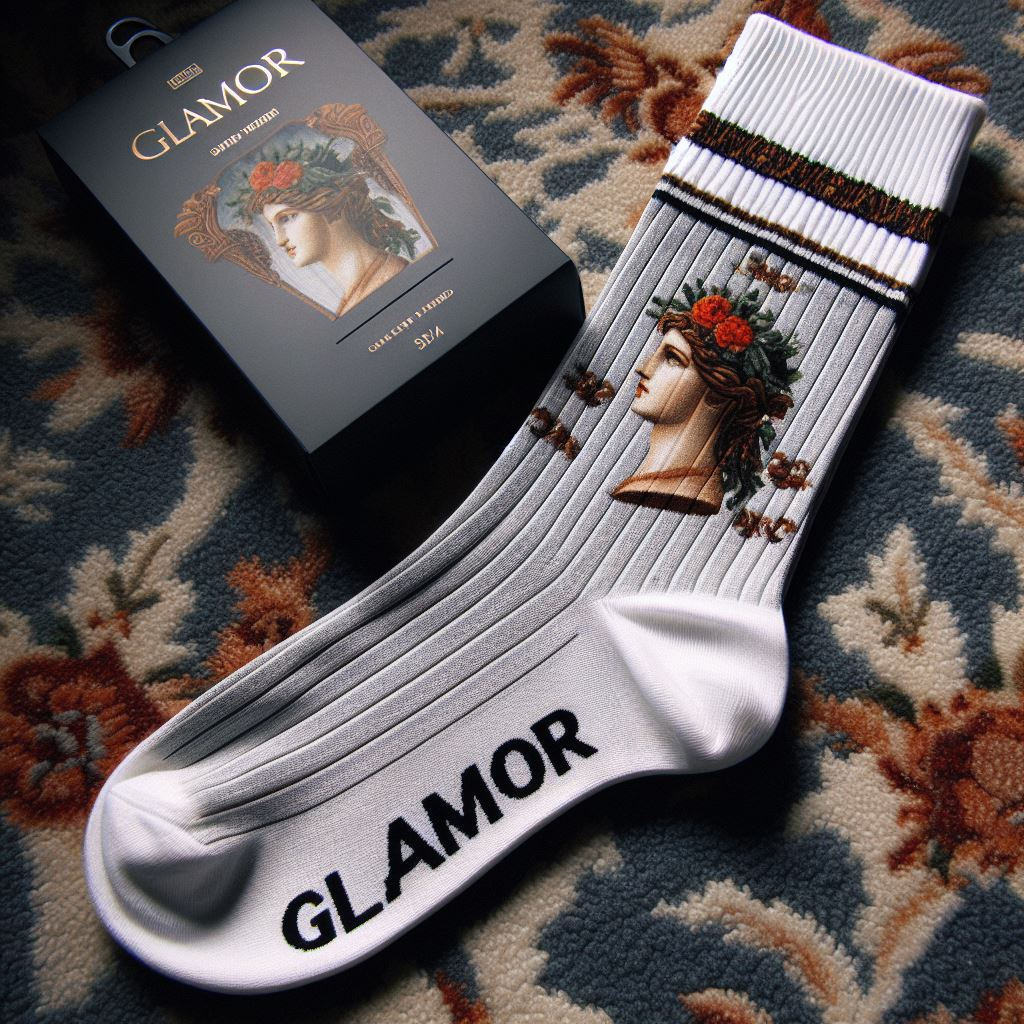
5. Unveiling the Potential: Digital Printing for Custom Sock Dreams
Digital printing has revolutionized the custom sock industry, offering a versatile and efficient method for creating socks that burst with vibrant colors and intricate details. Unlike traditional screen printing, digital printing utilizes cutting-edge technology to translate your designs directly onto the sock fabric.
The Magic of Digital Printing:
Digital printing boasts a streamlined process that brings your vision to life:
- Design Preparation: Your custom sock design is created digitally using graphic design software.
- Printing Process: The design is sent to a specialized digital printer equipped with inkjet printheads. These printheads precisely jet-pigmented inks directly onto the sock fabric.
- Curing and Finishing: The printed socks undergo a curing process to ensure ink permanence and washfastness. Additional finishing touches might be applied depending on the specific design.
Pros of Digital Printing:
- Unmatched Design Flexibility: Digital printing excels at handling intricate details, complex designs, and even photorealistic images, offering exceptional design freedom.
- Vibrant Colors and Details: Expect exceptional color accuracy and crisp details, ensuring your custom socks showcase your design in all glory.
- Small Batch Viability: Unlike screen printing, digital printing doesn't require expensive screen setups, making it suitable for smaller custom sock orders.
Cons of Digital Printing:
- Material Considerations: While digital printing works well on various fabrics, some materials might require pre-treatment or specific ink types for optimal results.
- Potential for Cost Variations: The cost per sock might vary depending on the complexity of the design, ink usage, and the specific printing method employed within the digital printing umbrella.
- Speed Considerations: While faster than traditional methods, digital printing might have slightly longer turnaround times than simpler techniques like heat transfer printing.
Perfect for:
- Complex Designs: If your vision involves intricate details, gradients, photorealistic elements, or full-color designs, digital printing is the ideal choice.
- Small Batch Orders: Whether you need a few pairs for a special occasion or want to test a design before production, digital printing caters to smaller quantities.
- Custom Sock Businesses: For businesses offering custom sock creation, digital printing provides the versatility and quality needed to fulfill diverse customer requests.
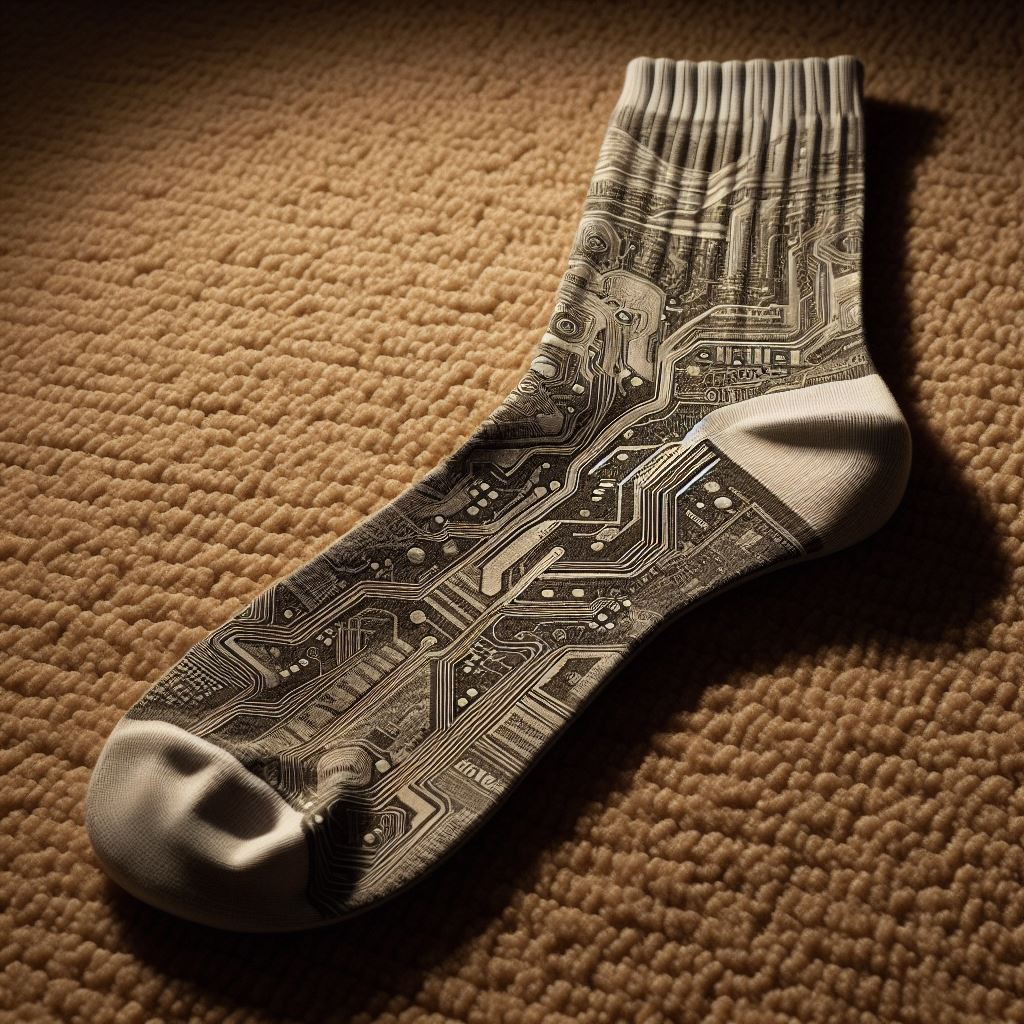
6. Foil Frenzy: Adding Dazzling Dimension with Foil Printing for Custom Socks
For those seeking to elevate their custom socks beyond ordinary prints, foil printing emerges as a captivating option. The technique imbues your designs with a metallic shine, creating a sophisticated and eye-catching effect.
The Art of Foil Application:
Foil printing isn't your typical printing method. It utilizes a specialized process to transfer metallic foil onto the sock surface:
- Design Preparation: Your custom sock design incorporates the elements you want embellished with metallic foil.
- Adhesive Application: A heat-activated adhesive is applied to the sock fabric following your design layout.
- Foil Stamping: A metallic foil sheet is placed over the sock, and a heated press applies pressure, causing the foil to adhere to the areas with adhesive.
- Excess Removal: They remove the excess foil, revealing your design elements gleaming in metallic splendor.
Pros of Foil Printing:
- Luxurious Shine: Foil printing adds a touch of sophistication and elegance, making your custom socks stand out from the crowd.
- Versatility in Design: Metallic foil can be used for logos, text, patterns, or accents, offering creative freedom for your design.
- Durable Finish: When applied correctly, foil printing can withstand washing and wear without peeling or flaking.
Cons of Foil Printing:
- Limited Color Options: While various metallic foil colors exist (gold, silver, rose gold, etc.), the color palette is inherently limited compared to printing methods.
- Potential for Cost Increase: Adding foil printing can increase the cost of your custom socks compared to plain printing methods.
- Design Suitability: Foil printing excels with bold outlines and simpler designs. Intricate details might not translate as effectively.
Perfect for:
- Logos and Text: Elevate your custom sock branding or personalized text with a metallic shine.
- Geometric Patterns and Accents: Create eye-catching geometric patterns or use foil accents to highlight specific design elements.
- Dress Socks and Special Occasions: Add a touch of sophistication to your dress socks for a formal event, or create custom socks for a special occasion with a touch of metallic flair.

7. Stitching Up Style: Exploring Embroidery for Custom Socks
Embroidery transcends the realm of printing, offering a unique and tactile way to personalize your custom socks. Imagine your designs meticulously stitched onto the sock fabric, creating a raised, textured embellishment that adds a touch of craftsmanship and timeless elegance.
The Art of Stitching: Bringing Designs to Life with Embroidery
Embroidery for custom socks involves a computerized embroidery machine that transforms your design into a stitched reality:
- Design Digitization: Your custom sock design is converted into a digital format that the embroidery machine can understand. This process creates a stitch map, outlining the path the embroidery needles will follow.
- Thread Selection: Threads are chosen to match your design colors and the sock fabric material.
- Embroidery Process: The sock is secured in an embroidery hoop, and the machine meticulously embroiders your design using the programmed stitch map.
Pros of Embroidery:
- Unique Textured Effect: Embroidery adds a raised, dimensional element to your sock design, creating a unique and visually appealing texture.
- Durability and Washfastness: Embroidered designs are durable and can withstand washing without fading or unraveling.
- Versatility in Design: While some limitations exist, embroidery can handle text, logos, and even simpler graphic elements.
Cons of Embroidery:
- Limited Design Complexity: Intricate details or photorealistic images might not translate well with embroidery due to stitching limitations.
- Larger Minimum Order Quantities (MOQs): Embroidery often requires higher MOQs than some printing methods due to the setup and programming involved.
- Cost Considerations: Embroidery can be more expensive than some printing methods, especially for complex designs with multiple thread colors.
Perfect for:
- Text and Logos: Embroidery excels at creating crisp and legible text or stitching logos for a classic and professional look.
- Monograms and Names: Personalize your custom socks with embroidered initials, monograms, or names for a unique touch.
- Simple Designs and Motifs: Simple graphic elements, patterns, or small mascots can be effectively embroidered onto your socks.
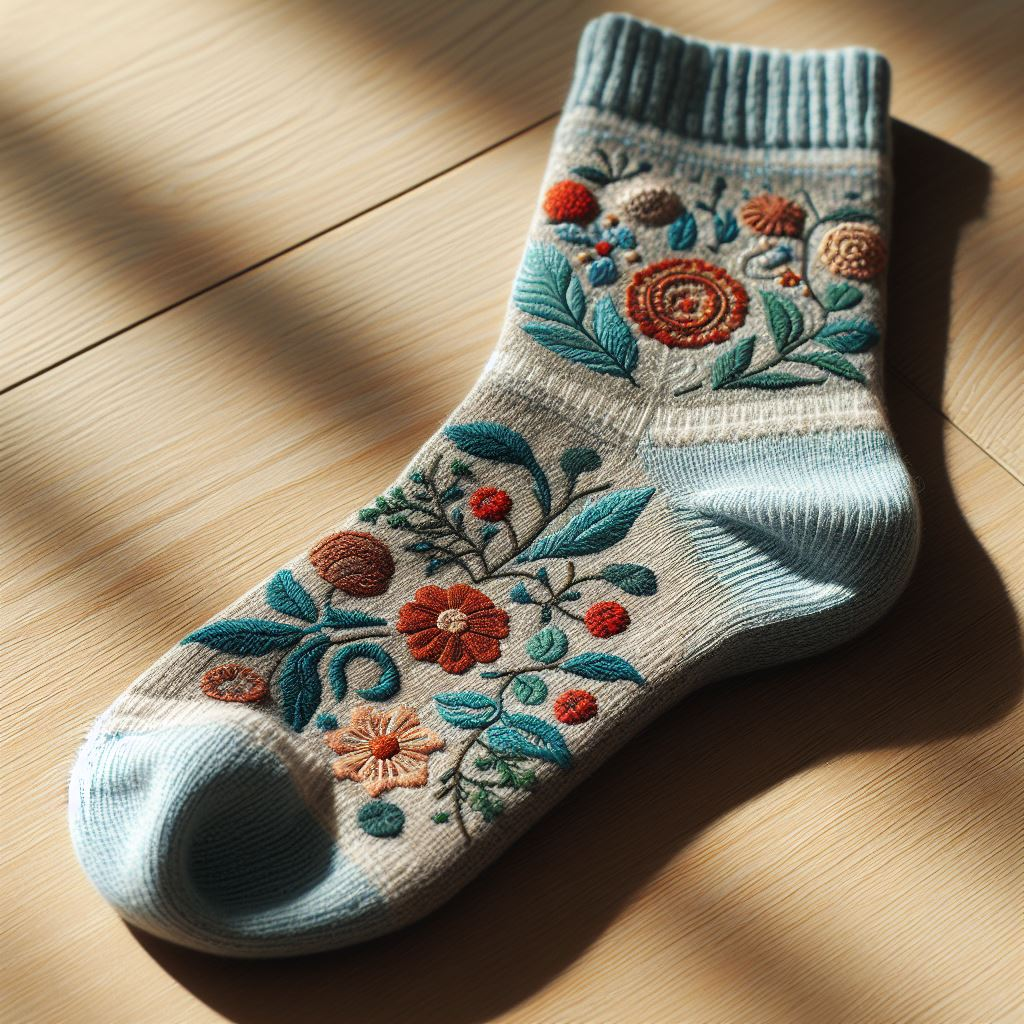
8. Applique Magic: Adding Dimension and Flair to Custom Socks with Applique
Applique takes custom sock design beyond flat printing by introducing a layer of textured embellishments. This technique involves attaching pre-cut fabric shapes onto the sock surface, creating a dimensional and visually interesting effect.
The Art of Applique: Layering Fabric for Customized Sock Magic
Applique for custom socks involves meticulous handiwork and a touch of artistry:
- Design Creation: Your custom sock design is created, specifying the elements you want to embellish with applique.
- Fabric Selection: Fabrics that complement the sock material and design theme are chosen for the applique pieces.
- Piece Creation: The applique shapes are precisely cut from the chosen fabrics using dies or laser cutters for intricate designs.
- Attachment: The applique pieces are carefully sewn or heat-sealed onto the sock surface, following the design layout.
Pros of Applique:
- Textured Dimension: Applique adds a layer of texture and visual interest to your sock design, making it stand out from flat-printed designs.
- Material Versatility: A wide range of fabrics, from felt and leather to sequins and reflective materials, can be used for applique, offering design flexibility.
- Eye-Catching Details: Create intricate designs or logos that wouldn't be possible with traditional printing methods.
Cons of Applique:
- Production Time and Cost: The meticulous handwork in applique can lead to longer production times and potentially higher costs than printing methods.
- Durability Considerations: The applique pieces might not withstand vigorous washing or wear, and some printed designs, especially with sewn attachments.
- Design Complexity: While intricate applique designs are possible, very small details might be difficult to execute.
Perfect for:
- Bold Logos and Mascots: Bring your team spirit or brand logo to life with a dimensional applique for a unique and eye-catching display.
- Multi-Textured Designs: Combine applique with embroidery or other embellishments to create custom socks with a rich and visually intriguing texture.
- Limited Edition or Specialty Socks: For special occasions or limited-edition sock designs, applique adds handcrafted exclusivity.
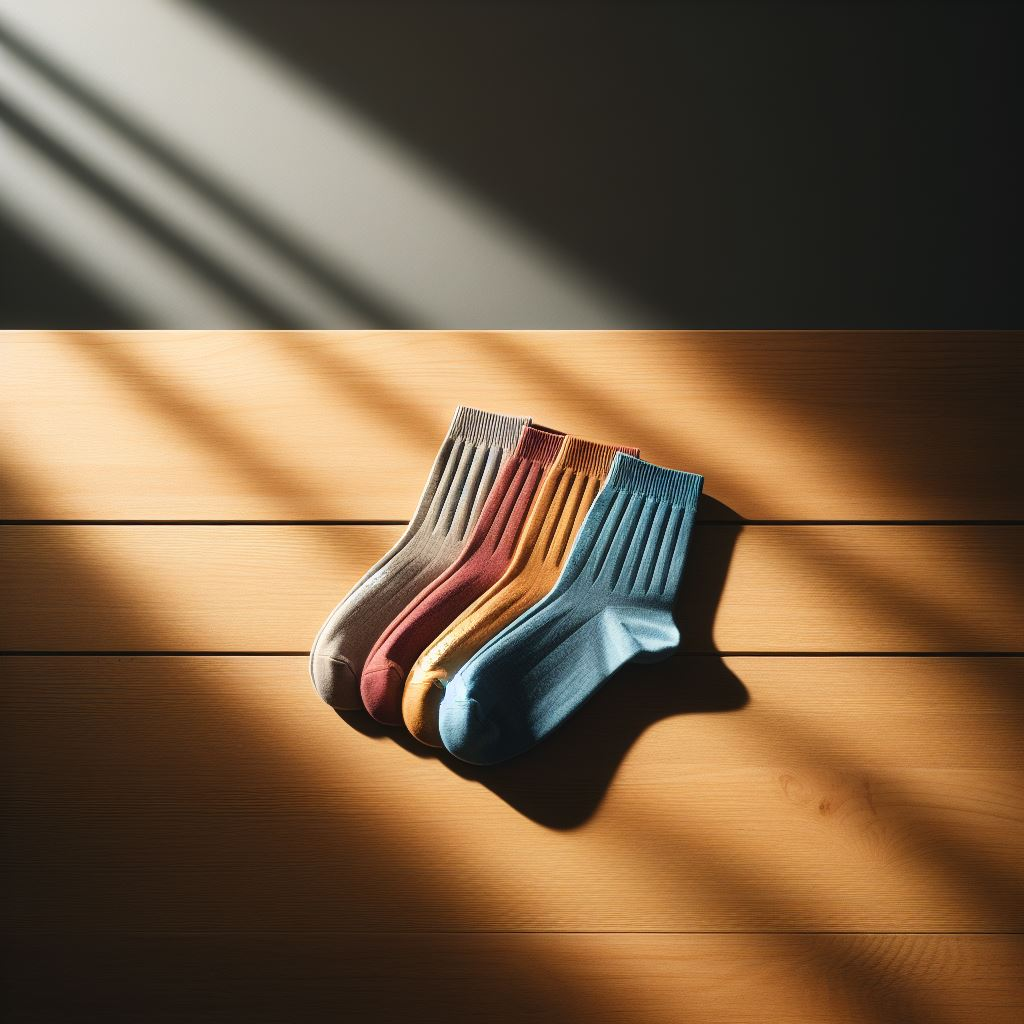
A few examples of EverLighten's work:
EverLighten demonstrates its expertise in custom sock manufacturing by catering to a wide range of client needs and overcoming various challenges through the use of unique techniques:
- Complex Artwork on Knit Socks: EverLighten addressed the Control Industry's challenge of intricate artwork on knit socks by collaborating to simplify the design while maintaining quality and meeting tight deadlines.
- Revised Design for Top-Quality Printed Socks: EverLighten's commitment to quality was evident when they identified limitations in the original design for By Light Professional IT Services. Communication and collaboration resulted in a revised design that exceeded expectations, leading to repeat orders.
- 360° Printing for Intricate Details: EverLighten's dedication to client satisfaction is evident in their solution for Soxieco's complex designs. While other manufacturers hesitated, EverLighten embraced the challenge and successfully used 360° printing to achieve the desired outcome.

EverLighten: Your One-Stop Shop for Custom Sock Dreams
Whether you're a brand seeking the perfect promotional giveaway, an artist with a vision for wearable masterpieces, or a company looking to create unique employee apparel, EverLighten is here to turn your custom sock dreams into reality.
We've showcased how our expertise tackles various challenges, from intricate artwork on knit socks to achieving exceptional quality with complex designs. EverLighten is your sock partner because we offer:
- 100% Customization: Design your socks exactly how you envision them, from toe to cuff.
- 100% Quality Check: We meticulously inspect every sock to ensure flawless results.
- Free Design Help: Our design team collaborates with you to bring your ideas to life.
- Worldwide Delivery: We ship your creations anywhere in the world.
- 24/7 Support: Don't let questions slow you down. Our 24/7 support ensures you get the answers you need anytime.
- Unlimited Revisions: We refine your design until you're satisfied.
- Low MOQ: Get started with small batches or create large-scale productions.
Are you ready to design custom socks that stand out from the crowd? Contact EverLighten today! We'll guide you through the process and help you create show-stopping socks that perfectly represent your brand, personality, or artistic vision. Reach out to our team to discuss your custom sock needs and unleash your creativity with EverLighten!
FAQs:
- What are the advantages and disadvantages of embroidery for custom socks?
- Advantages: Embroidery offers a unique textured look, excellent durability, and versatility for text, logos, and simple graphics.
- Disadvantages: Complex designs or photorealistic images might not translate well, minimum order quantities can be higher, and more expensive than some printing methods.
- Is applique a suitable choice for athletic socks?
While applique can add a unique touch, it might not be ideal for athletic socks due to durability concerns. The applique pieces might snag or wear down faster with vigorous activity.
- What are the benefits of using heat transfer vinyl (HTV) for custom socks?
HTV offers a simple and affordable approach for small-batch personalization. It's great for adding names, initials, or logos but is limited in design complexity and long-term durability compared to other methods.
- Is digital printing suitable for small orders of custom socks?
Unlike traditional screen printing, digital printing doesn't require expensive setups, making it a viable option for smaller custom sock orders. It also excels at intricate details, complex designs, and vibrant colors.
- What factors should I consider when choosing a printing technique for my custom socks?
Consider the design complexity, desired material, budget, and order quantity. For intricate designs or small batches, digital printing might be ideal. Embroidery could be a choice for a luxurious touch and a classic look. Think about the sock's intended use; athletic socks might benefit from printing methods that ensure durability.

